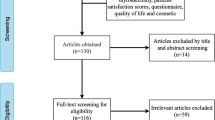Abstract
Purpose
The Self-Assessment Questionnaire for Cosmetic Outcomes (SAQCO) was developed by us to evaluate the cosmetic outcome of patients after thyroidectomy. This study aimed to examine the reliability and validity of SAQCO.
Methods
We analyzed the cosmetic outcomes of 368 patients who underwent thyroidectomy and completed the SAQCO 1 year after surgery. The one-dimensionality, reliability, and validity of SAQCO were assessed using factor analysis models, Cronbach’s alpha, and test–retest statistics. The differences in cosmesis indices between patient characteristics and surgical parameters were analyzed through comparative and regression analyses.
Results
The unidimensional convergence of SAQCO was examined. A Cronbach’s alpha of 0.91, strong item-total correlation values (from 0.77 to 0.89), and a test–retest correlation value of 0.86 indicated the internal consistency and reliability of the SAQCO. The cosmesis index was significantly highest in the transoral (92.3 points) and transaxillary groups (90.9 points), followed by the postauricular (84.8 points) and transcervical groups (76.4 points).
Conclusion
This study examined the reliability and validity of the SAQCO and showed that it is a suitable questionnaire for assessing cosmetic satisfaction of patients after thyroidectomy. The transoral and transaxillary approaches yield significantly superior cosmetic results compared to the conventional transcervical and postauricular approaches.
Similar content being viewed by others
Data availability
Most of the data used in the study are included in this article. Additional data are available from the corresponding author upon reasonable request.
References
Christoforides C, Dionigi G, Vasileiou L, Vamvakidis K (2018) A historical account for thyroid surgery. J Endocr Surg 18:1–9. https://doi.org/10.16956/jes.2018.18.1.1
Tae K, Ji YB, Song CM, Ryu J (2019) Robotic and endoscopic thyroid surgery: evolution and advances. Clin Exp Otorhinolaryngol 12:1–11. https://doi.org/10.21053/ceo.2018.00766
Tae K (2021) Robotic thyroid surgery. Auris Nasus Larynx 48:331–338. https://doi.org/10.1016/j.anl.2020.06.007
Lee DW, Bang HS, Jeong JH, Kwak SG, Choi YY, Tae K (2021) Cosmetic outcomes after transoral robotic thyroidectomy: comparison with transaxillary, postauricular, and conventional approaches. Oral Oncol 114:105139. https://doi.org/10.1016/j.oraloncology.2020.105139
Kasouli A, Spartalis E, Giannakodimos A, Tsourouflis G, Dimitroulis D, Nikiteas NI (2022) Comparison of cosmetic outcomes between remote-access and conventional thyroidectomy: a review of the current literature. World J Otorhinolaryngol Head Neck Surg 9:1–8. https://doi.org/10.1002/wjo2.65
Chung EJ, Park MW, Cho JG, Baek SK, Kwon SY, Woo JS, Jung KY (2015) A prospective 1-year comparative study of endoscopic thyroidectomy via a retroauricular approach versus conventional open thyroidectomy at a single institution. Ann Surg Oncol 22:3014–3021. https://doi.org/10.1245/s10434-014-4361-7
Lee H, Lee J, Sung KY (2012) Comparative study comparing endoscopic thyroidectomy using the axillary approach and open thyroidectomy for papillary thyroid microcarcinoma. World J Surg Oncol 10:269. https://doi.org/10.1186/1477-7819-10-269
Jantharapattana K, Maethasith J (2017) Transaxillary gasless endoscopic thyroidectomy versus conventional open thyroidectomy: a randomized study. Eur Arch Otorhinolaryngol 274:495–500. https://doi.org/10.1007/s00405-016-4242-8
Economopoulos KP, Petralias A, Linos E, Linos D (2012) Psychometric evaluation of patient scar assessment questionnaire following thyroid and parathyroid surgery. Thyroid 22:145–150. https://doi.org/10.1089/thy.2011.0265
O’Connell DA, Diamond C, Seikaly H, Harris JR (2008) Objective and subjective scar aesthetics in minimal access vs conventional access parathyroidectomy and thyroidectomy surgical procedures: a paired cohort study. Arch Otolaryngol Head Neck Surg 134:85–93. https://doi.org/10.1001/archotol.134.1.85
Durani P, McGrouther DA, Ferguson MW (2009) The patient scar assessment questionnaire: a reliable and valid patient-reported outcomes measure for linear scars. Plast Reconstr Surg 123:1481–1489. https://doi.org/10.1097/prs.0b013e3181a205de
Ji YB, Song CM, Bang HS, Lee SH, Park YS, Tae K (2014) Long-term cosmetic outcomes after robotic/endoscopic thyroidectomy by a gasless unilateral axillo-breast or axillary approach. J Laparoendosc Adv Surg Tech A 24:248–253. https://doi.org/10.1089/lap.2013.0459
Lee DW, Ko SH, Song CM, Ji YB, Kim JK, Tae K (2020) Comparison of postoperative cosmesis in transaxillary, postauricular facelift, and conventional transcervical thyroidectomy. Surg Endosc 34:3388–3397. https://doi.org/10.1007/s00464-019-07113-1
Devellis RF (2016) Guidelines in scale development. In: Scale development: theory and applications, 4th edn. Sage publications Ltd, London, pp 73–114
Shrestha N (2021) Factor analysis as a tool for survey analysis. Am J Appl Math 9:4–11. https://doi.org/10.12691/ajams-9-1-2
Guttman L (1954) Some necessary conditions for common-factor analysis. Psychometrika 19:149–161. https://doi.org/10.1007/BF02289162
Cronbach LJ (1951) Coefficient alpha and the internal structure of tests. Psychometrika 6:297–334. https://doi.org/10.1007/BF02310555
Tavakol M, Dennick R (2011) Making sense of Cronbach’s alpha. Int J Med Educ 2:53. https://doi.org/10.5116/ijme.4dfb.8dfd
Azen R, Walker CM (2021) Modeling and the generalized linear model. In: Categorical data analysis for the behavioral and social sciences, 2nd edn. Routledge, New York, pp 117–136
Tae K, Ji YB, Song CM, Park JS, Park JH, Kim DS (2020) Safety and efficacy of transoral robotic and endoscopic thyroidectomy: the first 100 cases. Head Neck 42:321–329. https://doi.org/10.1002/hed.25999
Funding
This study received no external funding.
Author information
Authors and Affiliations
Corresponding author
Ethics declarations
Conflict of interest
The authors declare that there are no conflicts of interest.
Ethics approval
This study was approved by the Institutional Review Board of Hanyang University Hospital (approval number 2023-07-012).
Informed consent
Informed consent was obtained from all individual participants involved in the study.
Additional information
Publisher's Note
Springer Nature remains neutral with regard to jurisdictional claims in published maps and institutional affiliations.
Rights and permissions
Springer Nature or its licensor (e.g. a society or other partner) holds exclusive rights to this article under a publishing agreement with the author(s) or other rightsholder(s); author self-archiving of the accepted manuscript version of this article is solely governed by the terms of such publishing agreement and applicable law.
About this article
Cite this article
Nguyen, V.C., Song, C.M., Ji, Y.B. et al. Evaluation of the validity and reliability of a self-assessment questionnaire for cosmetic outcomes after thyroidectomy: a cross-sectional validation study. Eur Arch Otorhinolaryngol 281, 1505–1513 (2024). https://doi.org/10.1007/s00405-023-08395-x
Received:
Accepted:
Published:
Issue Date:
DOI: https://doi.org/10.1007/s00405-023-08395-x



